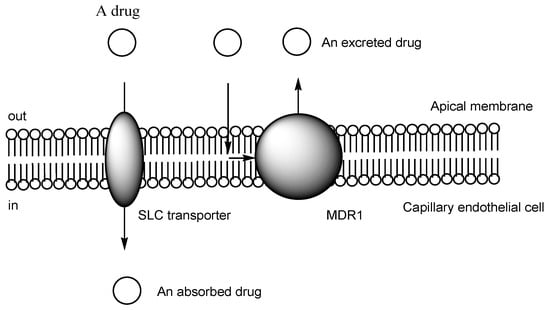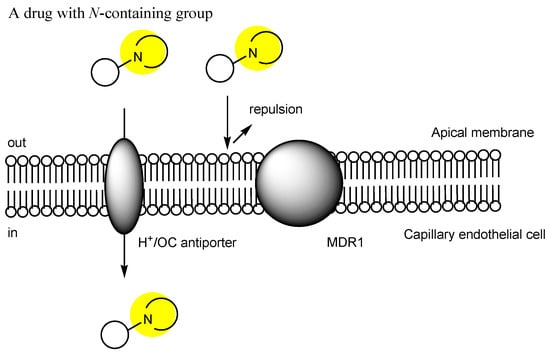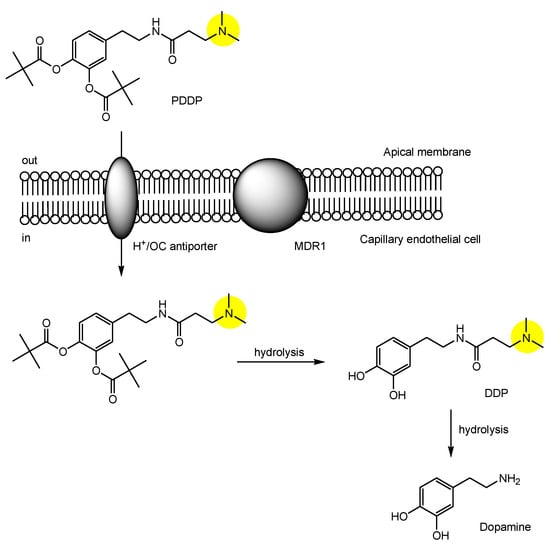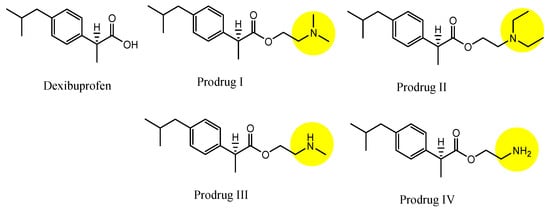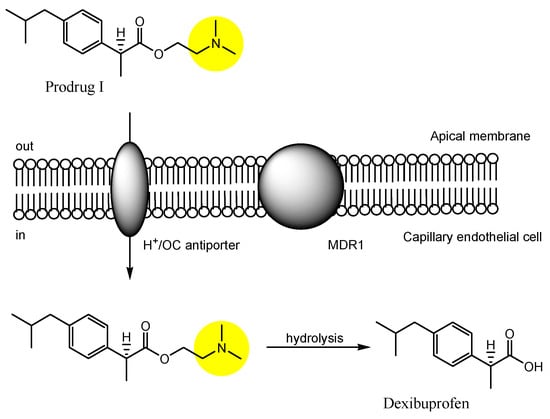2. Transporter-Conscious Drug Design
Transporters
[12] are membrane transport proteins that absorb or excrete materials across the cell membrane through homeostatic mechanisms. They play a pharmacokinetic role in absorption, distribution, metabolism, and excretion (ADME). Efflux transporters, such as the ATP-binding cassette (ABC) transporters, eliminate waste or hydrophobic toxic materials from cells
[13]. On the other hand, transporters that mediate facilitated diffusion, such as the solute carrier (SLC) transporters [
Table 1]
[14], absorb water-soluble nutritive materials into cells or transport them out of cells to the tissues in need. Representative SLC transporters include peptide transporters, amino acid transporters, organic anion transporters (OCTs), and glucose transporters, reflecting their respective substrates. In general, peptide transporters carry peptides as substrates, while amino acid transporters carry amino acids as substrates. It is true that some substrates may be recognized by multiple transporters simultaneously. However, transporters named after their substrates generally do not transport compounds other than those substrates. Accordingly, SLC transporters recognize the structures of their substrates during transportation, although they may demonstrate relaxed substrate specificity in some cases. Thus, compounds that mimic the structure of various transporter substrates can also be transported by those respective transporters. Transporter-conscious drug design is a promising strategy for drug delivery
[3][4]. Mechanically, SLC transporters are categorized into uniporters, symporters, and antiporters based on their material transport mechanisms. The transport mechanisms of SLC transporters, driven by concentration gradient energy, have not been completely elucidated yet, primarily due to the challenging analysis of temporal dynamic changes in microstructure. However, X-ray crystal structures of SLC transporter protein-substrate complexes have revealed binding modes at a molecular level, both in an inward-open state
[15] and in an outward-open state
[16], consistent with an alternating access mechanism
[17]. These findings regarding the interaction between the binding sites of various transporters and the transporter recognition units of corresponding substrates are beneficial for transporter-conscious drug design. Computational calculations can suggest transport mechanisms. The structures of designed drugs need to be refined and optimized through iterative transport experiments conducted in vitro and in vivo.
Table 1. Representative solute carrier (SLC) transporters.
3. Implementation of Transporter-Conscious Drug Design with N-Containing Groups
Transporters recognize the structures of their substrates. Therefore, compounds with transporter recognition units can be transported across the membrane through the pores of their corresponding transporters. There are two approaches to transporter-conscious drug design: (i) drug compounds that possess N-containing groups on their own, and (ii) conjugates of drugs and compounds that possess N-containing groups with appropriate linkers.
Fundamentally, the design of substrates for H
+/OC antiporters can be achieved by emulating current CNS drugs that contain
N-containing groups, such as the
N,
N-dimethylalkyl groups. In CNS drug development,
N-containing groups are introduced either inadvertently or through empirical methods. In practice, drugs linked to
N-containing transporter recognition units via cleavable linkers can be transported across the BBB or BRB by H
+/OC antiporters. After these linkers are cleaved, the delivered drugs will exhibit their activity accordingly, following the prodrug system. Strictly speaking, the parent compounds may be enzymatically generated from their respective prodrugs in capillary endothelial cells before the prodrugs permeate the basolateral membrane, either in the cerebrospinal fluid (CSF) or in the brain parenchyma after the prodrugs permeate the basolateral membrane. This process depends on the characteristics of the compounds and the design of the drugs. The mechanism by which existing CNS drugs with
N-containing groups cross the basolateral membrane after H
+/OC antiporter-mediated internalization into capillary endothelial cells across the apical membrane is not yet understood. It is thought that they probably cross the basolateral membrane into the CSF not through passive diffusion but rather through carrier-mediated transport or exocytosis, because the normal cellular pH level is approximately 7.0, which is slightly more acidic compared with the pH of approximately 7.4 in the blood. Nevertheless, the possibility of direct translocation, initiated by the interaction with anionic phosphatidylinositol 4,5-bisphosphate (PI(4,5)P2) at the inner lipid bilayer and cationic
N-containing groups, such as cytosolic full-length TAT (101 amino acids)
[18], cannot be firmly dismissed.
A pyrilamine derivative with the benzamide zinc-binding group as a histone deacetylase (HDAC) inhibitor has been shown to be absorbed into hCMEC/D3 cells through H
+/OC antiporter-mediated transport in an in vitro assay [
Figure 3] and to successfully cross the BBB in an in situ brain perfusion assay using rat. This compound exhibited HDAC1 inhibitory activity and holds promise as a brain-penetrating HDAC inhibitor for the treatment of CNS diseases
[19].
Figure 3. The mechanism of absorption mediated by the H+/OC antiporter for a pyrilamine derivative with an N-containing group, acting as a histone deacetylase inhibitor.
Diphenhydramine analogs were assessed for cellular uptake via the H
+/OC antiporter using hCMEC/D3 cells. Some of these exhibited more efficient transport than the unmodified original diphenhydramine. The rank order of initial uptake rate (mL/mg Protein/min) using hCMEC/D3 cells is D (293 ± 16) > C (273 ± 26) > B (188 ± 23) > diphenhydramine (127 ± 8) > G (114 ± 23) > F (105 ± 19) > E (76.9 ± 9.8) > A (31.6 ± 5.6) > J (16.4) > H (3.70 ± 0.50) > I (2.05 ± 0.63). It has been implied that a heterocyclic amine moiety serves as a favorable transporter recognition unit [
Figure 4]
[20].
Figure 4. The rank order of transport across the membrane through H+/OC antiporter in in vitro assay among diphenhydramine and its derivatives (A–J).
Chlorambucil (CHL), a chemotherapy medication, cannot penetrate the membrane due to the hydrophilic nature of the carboxyl group. The prodrug chlorambucil-scopine (CHLS), a conjugate of CHL and scopine linked by an ester bond, was observed to cross the BBB in an in vitro assay using murine brain endothelial cells and in an in situ rat brain perfusion assay. This internalized prodrug was enzymatically cleaved to trigger its activity against glioma in the brain. The
N-containing scopine unit was identified as a substrate by the H
+/OC antiporter, as evidenced by the lack of inhibition of this transport by TEA [
Figure 5]
[21][22]. The parent compound chlorambucil would remain in the brain without crossing the BBB in the opposite direction.
Figure 5. The mechanism of H+/OC antiporter-mediated absorption and metabolism of the prodrug chlorambucil-scopine with an N-containing group.
N-[3,4-bis(pivaloyloxy)dopamine]-3-(dimethylamino)propanamide (PDDP) is a double prodrug of dopamine, consisting of the conjugation of dopamine with pivaloyl groups on the phenolic hydroxy groups and the 3-(dimethylamino)propanoyl group serving as the transporter recognition unit. PDDP was distributed in the brain in an in vivo assay based on intravenous injection in rats. PDDP was likely internalized into cells via the H
+/OC antiporter and subsequently hydrolyzed to form dopamine in an in vitro assay using bEnd.3 cells [
Figure 6]. This transport was inhibited by pyrilamine, propranolol, and imipramine, but not by choline, L-carnitine, and TEA
[23].
Figure 6. The mechanism of H+/OC antiporter-mediated absorption and metabolism of the prodrug PDDP with N-containing group, which was subject to enzymatic hydrolysis to form the parent compound DDP and eventually dopamine.
The transport evaluation of dexibuprofen and its prodrugs, including prodrug I with the (
N,
N-dimethylamino)ethyl group, prodrug II with the (
N,
N-diethylamino)ethyl group, prodrug III with the (
N-methylamino)ethyl group, and prodrug IV with the aminoethyl group, was conducted [
Figure 7 and
Figure 8]. The rank order of transport across the membrane through H
+/OC antiporter in an in vitro assay using capillary endothelial cells was prodrug I > prodrug II > prodrug III > prodrug IV > dexibuprofen. The cellular uptakes of prodrug I, prodrug II, prodrug III, prodrug IV, and dexibuprofen in the right brain hemisphere at 37 °C were 117.69 ± 20.66, 99.59 ± 9.88, 66.51 ± 16.85, 50.03 ± 11.76, and 9.24 ± 1.50 (nmol/g), respectively, in an in vivo rat brain perfusion assay
[24]. The (
N,
N-dimethylamino)ethyl group was identified as a potent H
+/OC antiporter recognition unit.
Figure 7. The structures of dexibuprofen and its prodrugs.
Figure 8. The mechanism of H+/OC antiporter-mediated absorption and metabolism of the dexibuprofen prodrug, which possesses an N-containing group as a transporter recognition unit.
Currently, research in low-molecular-weight drug delivery aimed at crossing the BBB through carrier-mediated transport is being conducted, targeting characteristically identified transporters such as glucose transporter 1 (GLUT1), probably because of the ease of rational drug design
[25]. Furthermore, GLUT1 is expressed on both the apical and basolateral membranes of capillary endothelial cells, facilitating the successive transport of its substrate from the bloodstream into the brain. Thus, it is important to identify the H
+/OC antiporter as early as possible to advance research in drug delivery, although its features have already been investigated
[26][27]. The pharmacophore for the H
+/OC cation antiporter inhibitor was calculated using computer software based on data obtained from in vitro competitive permeation assays using labeled substrates in hCMEC/D3 cells
[28]. Similarly, the chemophore, serving as a transporter recognition unit, can be obtained through calculation
[4][29]. If the three-dimensional structural information of the H
+/OC cation antiporter is utilized, transporter-conscious drug design targeting it will be conducted with high accuracy. Nevertheless, the design of compounds to cross the BBB has often been undertaken empirically, unconsciously, and fortuitously by incorporating
N-containing groups as transporter recognition units, without making use of identified transporters such as GLUT1. This is highly significant in CNS or eye drug development because it indicates the ease of H
+/OC cation antiporter-mediated transport.
Moreover, nanoparticles are commonly employed as carriers for the transendothelial delivery of not only low-molecular-weight drugs but also middle- and high-molecular-weight drugs
[3][30].

